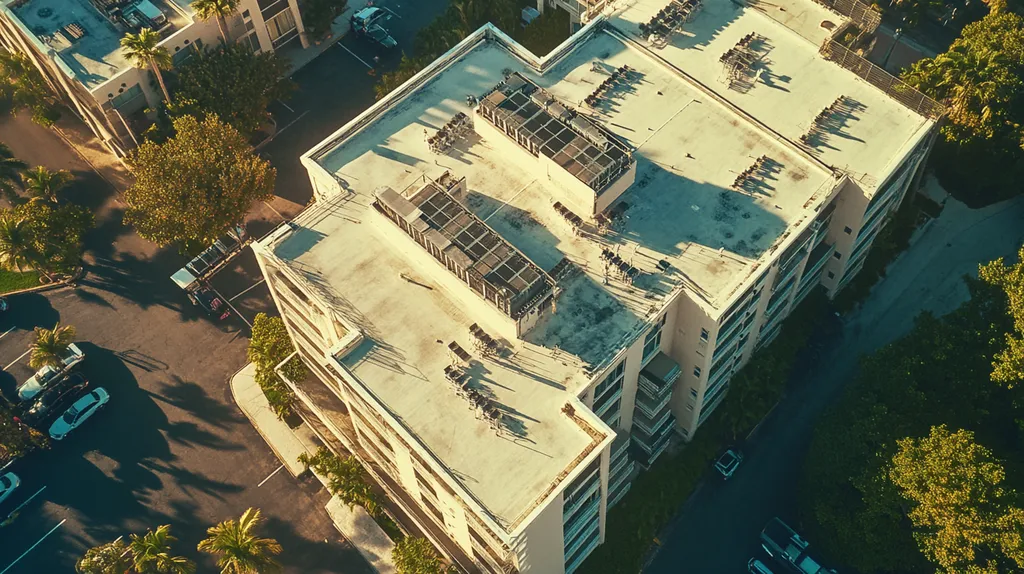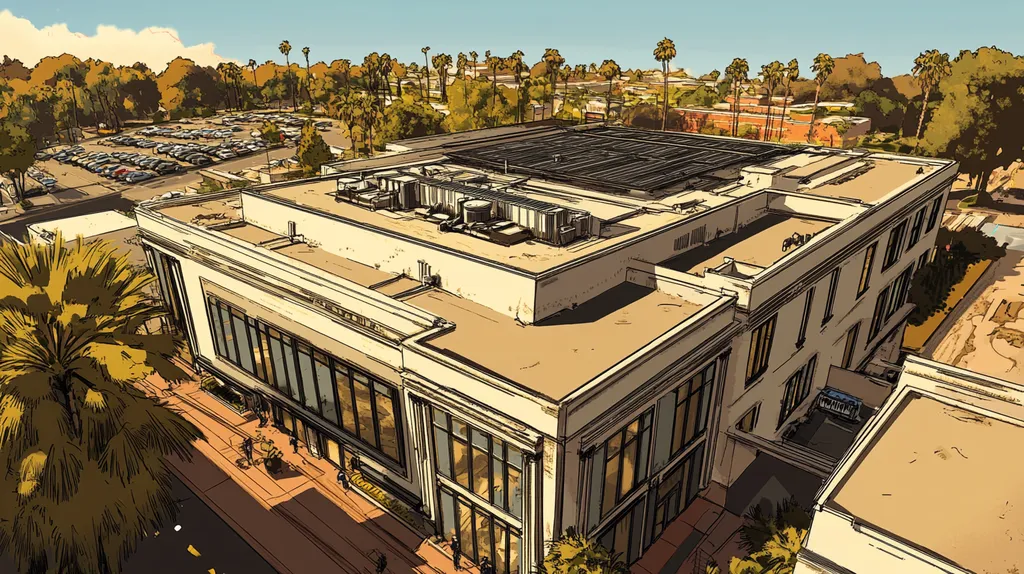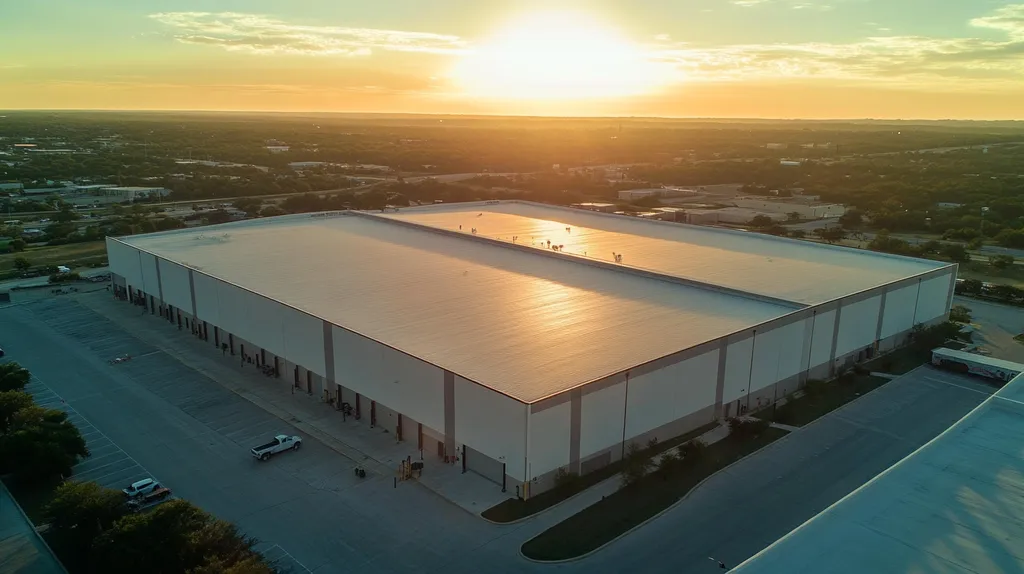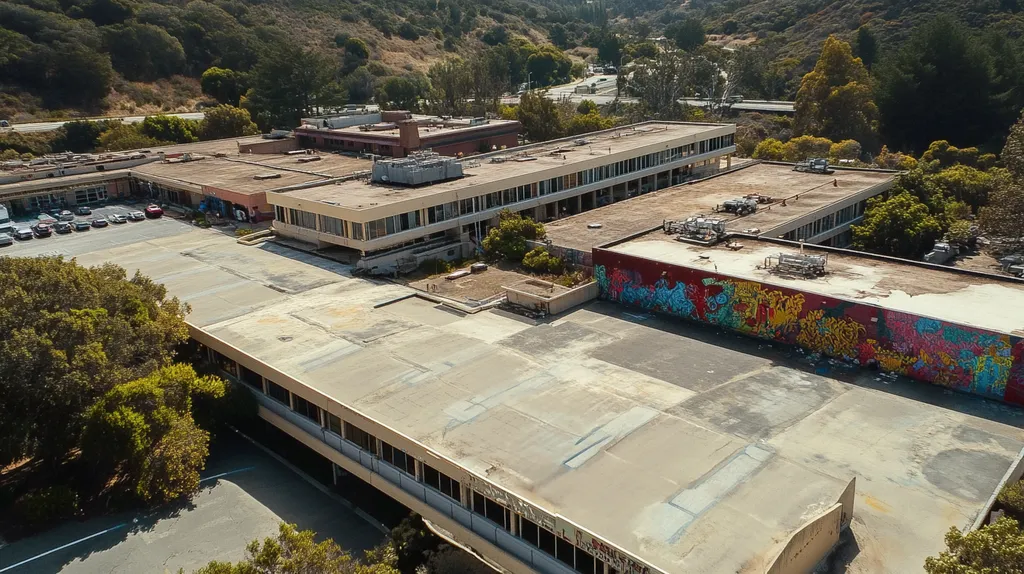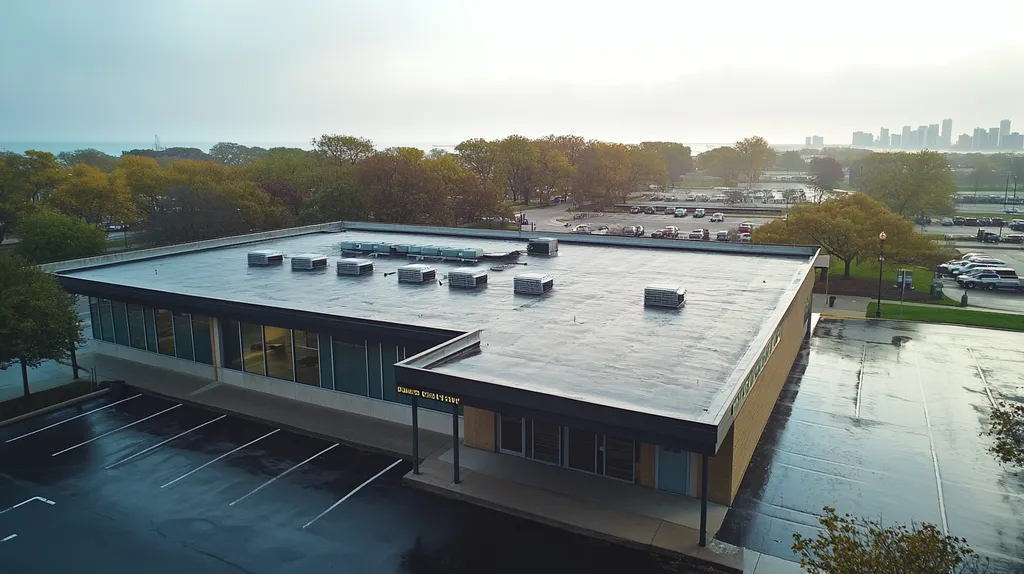Welcome to today’s Battle Royale featuring two roofing heavyweights: “TPO” in the east corner versus “PVC” in the west!
Tonight’s showdown pits these contenders against each other across six punishing rounds designed to test every aspect of their performance for Fire Ratings for Commercial Roofs.
At stake? Millions in potential costs, decades of building protection, and the critical performance demands of modern commercial and industrial facilities.
Our professional judging panel will evaluate each round on technical merit, real-world performance, and value delivery. After all six rounds, we’ll declare our ultimate champion.
Ladies and gentlemen, facility managers and building owners… it’s time to rumble!
ROUND 1: INITIAL COSTS & INSTALLATION
When selecting commercial roofing materials, property owners face critical decisions that impact both safety and budgets. Fire ratings, installation costs, and project timelines all play vital roles in the selection process between TPO and PVC systems. Making the wrong choice can lead to significant financial consequences and potential safety risks.
Material Expenses
TPO roofing materials typically cost 30-40% less than PVC alternatives, with TPO averaging $4-6 per square foot compared to PVC’s $7-9 per square foot. This significant price difference makes TPO an attractive initial option for budget-conscious property owners.
A Class A fire rating is the highest level of fire resistance a material can achieve, with a flame-spread index of 0-25 and smoke developed index of 0-450. Both TPO and PVC can achieve this superior rating when properly installed. (source: Roof Evolution)
While PVC commands a premium price, both materials offer comparable fire protection capabilities. The decision often comes down to budget constraints versus long-term durability expectations.
For pure material costs, TPO holds the ADVANTAGE.
Installation Complexity
Installation procedures significantly impact both project timelines and final costs. TPO installations generally require fewer specialized tools and techniques, making the process more straightforward for qualified contractors.
PVC installations demand more precise welding techniques and specialized equipment, increasing both labor costs and the potential for installation errors. This complexity can add 15-20% to labor costs.
While both materials require professional installation to maintain their fire ratings, TPO’s simpler installation process reduces the risk of application errors that could compromise safety features.
TPO demonstrates an ADVANTAGE in installation complexity.
Project Timeline
Project duration directly affects business operations and overall costs. TPO installations typically complete 20-30% faster than comparable PVC projects due to simpler application procedures.
PVC installations require more precise environmental conditions and longer curing times between steps. These factors can extend project timelines, particularly in challenging weather conditions.
Both materials require careful attention to detail during installation to maintain their fire-resistant properties, but TPO’s faster installation reduces facility disruption.
For project timeline efficiency, TPO claims another ADVANTAGE.
ROUND 1 WINNER: TPO
ROUND 2: DURABILITY & LIFESPAN
Commercial roofing durability directly impacts building protection, operational costs, and fire safety compliance. Every year of premature roof replacement can cost property owners hundreds of thousands in materials, labor, and business disruption. Understanding how TPO and PVC materials perform over time is crucial for making informed investment decisions that maintain both safety and value.
Material Resilience
TPO roofing demonstrates excellent initial durability, particularly in its resistance to UV radiation and temperature fluctuations. The material’s flexibility helps it withstand thermal cycling without developing stress cracks or surface deterioration.
Over time, however, TPO can become more susceptible to impact damage and may require more frequent inspections to maintain its protective properties. Standard TPO installations typically maintain their performance characteristics for 15-20 years with proper maintenance.
PVC roofing exhibits superior chemical resistance and maintains its protective properties longer than TPO. Its molecular structure provides inherent flame resistance that remains stable throughout its service life.
In severe exposure conditions, PVC consistently outperforms TPO in maintaining its protective capabilities. The material’s proven track record of 25-30 year lifespans makes it the clear choice for durability-focused installations.
For material resilience, PVC claims the ADVANTAGE.
Weather Resistance
TPO roofing performs well in most weather conditions, offering good resistance to heat, cold, and precipitation. The material’s white surface helps reflect UV rays and reduce thermal stress on the roofing system.
However, extreme weather events can accelerate TPO degradation, particularly in areas with frequent temperature swings or high heat exposure. The material may require more frequent maintenance to maintain its protective properties in challenging climates.
PVC demonstrates exceptional weather resistance across all climate zones. Its chemical composition provides superior resistance to ponding water, which can compromise roof integrity and fire resistance over time.
The material’s proven performance in extreme environments, from desert heat to arctic cold, makes it particularly valuable for facilities requiring consistent protection. For weather resistance, PVC shows clear ADVANTAGE.
System Longevity
TPO roofing systems typically provide 15-20 years of reliable service when properly installed and maintained. Regular inspections and prompt repairs can help extend this lifespan, particularly in moderate climate zones.
Standard TPO installations require more frequent maintenance checks to ensure seam integrity and surface condition remain within acceptable parameters. This increased maintenance requirement can impact long-term operational costs.
PVC systems demonstrate exceptional longevity, with many installations exceeding 30 years of service. The material’s stable chemical composition helps maintain its fire-resistant properties throughout its service life.
For system longevity, PVC demonstrates superior performance and claims the ADVANTAGE.
ROUND 2 WINNER: PVC
ROUND 3: PERFORMANCE FACTORS
Fire ratings directly impact building safety, insurance costs, and regulatory compliance for commercial properties. A single roofing decision can mean the difference between containing a fire incident or facing catastrophic losses. Understanding how TPO and PVC perform under fire conditions helps property owners make informed choices that protect both assets and occupants.
Fire Resistance Ratings
The Standard Test Methods for Fire Tests of Roof Coverings establishes three classifications (A, B, C) that evaluate how roofing materials perform under simulated fire conditions with wind exposure. These comprehensive tests assess performance on both combustible and noncombustible decks to ensure real-world protection. (source: Intertek)
TPO membranes can achieve Class A ratings through the addition of fire-retardant compounds during manufacturing. However, maintaining this rating requires precise installation and regular inspection to ensure protective qualities remain intact.
PVC membranes contain inherent fire-resistant properties in their base chemical composition. This natural resistance provides more consistent protection without relying solely on additional treatments or perfect installation conditions.
For fire resistance reliability, PVC claims the ADVANTAGE.
Impact on Insurance Costs
Insurance providers carefully evaluate roofing materials when determining coverage and premiums. Buildings with superior fire-rated roofing systems typically qualify for better rates and more comprehensive coverage options.
TPO systems can satisfy basic insurance requirements when properly installed and maintained. However, variations in manufacturing quality and installation precision can lead to inconsistent risk assessments by insurers.
PVC’s established track record and inherent fire resistance properties generally result in more favorable insurance terms. Many insurers specifically recognize PVC’s reliable performance in their risk calculations.
For insurance benefits, PVC demonstrates the ADVANTAGE.
Regulatory Compliance
Commercial buildings must meet strict fire safety codes that vary by jurisdiction and occupancy type. Failure to maintain compliance can result in fines, increased liability, and potential building closure.
TPO systems require careful documentation to demonstrate ongoing compliance with fire safety requirements. Changes in manufacturing processes or installation methods can affect regulatory status.
PVC’s consistent composition and documented performance make regulatory compliance more straightforward. The material’s stable properties help maintain compliance throughout its service life.
For regulatory certainty, PVC holds the ADVANTAGE.
ROUND 3 WINNER: PVC
ROUND 4: MAINTENANCE REQUIREMENTS
Proper maintenance of commercial roofing systems directly impacts fire safety ratings and long-term performance. Even minor maintenance oversights can compromise a roof’s fire resistance capabilities, potentially voiding warranties and insurance coverage. Understanding the maintenance demands of TPO versus PVC systems helps property owners protect their investments while ensuring consistent fire safety compliance.
Inspection Requirements
TPO roofing systems require bi-annual professional inspections to maintain their fire safety ratings. These inspections focus on seam integrity, membrane condition, and proper drainage to prevent issues that could compromise fire resistance.
The inspection process for TPO is relatively straightforward, with clear visual indicators of potential problems. Special attention must be paid to areas around roof penetrations and flashings where fire barriers are most vulnerable.
PVC systems demand more rigorous inspection protocols, particularly around chemical exposure areas. UL tests evaluate both external and internal fire resistance, requiring careful monitoring of the membrane’s condition to maintain these ratings. (source: Carlisle Syntec)
For inspection simplicity, TPO claims the ADVANTAGE.
Repair Procedures
TPO repairs typically involve straightforward procedures that can be completed quickly when problems are caught early. The material’s weldability allows for effective patches that maintain fire resistance properties without extensive system disruption.
Most TPO repairs can be completed using standard heat-welding equipment, making it easier to maintain consistent quality across repair work. This accessibility helps ensure fire safety features remain intact after maintenance.
PVC repairs require more specialized techniques and materials to maintain the system’s fire resistance properties. While repairs are generally permanent when properly executed, they demand higher skill levels and more precise environmental conditions.
For repair simplicity, TPO demonstrates an ADVANTAGE.
Long-term Care Requirements
TPO roofing systems benefit from simple cleaning protocols that help maintain their fire-resistant properties. Regular debris removal and basic surface cleaning are usually sufficient to prevent degradation of protective features.
The material’s resistance to biological growth reduces the need for harsh cleaning chemicals that could potentially compromise fire safety ratings. This characteristic helps maintain consistent protection with minimal intervention.
PVC systems require more specialized care to maintain their fire resistance properties over time. Chemical exposure and environmental factors can necessitate more frequent maintenance interventions to ensure consistent protection levels.
For ongoing maintenance requirements, TPO claims the ADVANTAGE.
ROUND 4 WINNER: TPO
ROUND 5: SUSTAINABILITY CREDENTIALS
Environmental standards and building codes increasingly emphasize sustainable roofing practices, making material selection critical for long-term compliance. Beyond environmental impact, sustainable roofing choices directly affect energy costs, building certification status, and property values. Today’s commercial property owners must balance immediate performance needs with growing pressure for sustainable building practices.
Recyclability and Life Cycle Impact
TPO roofing materials demonstrate excellent recyclability at end-of-life, with many manufacturers operating take-back programs. The manufacturing process requires less energy than traditional materials, resulting in a smaller carbon footprint from production to installation.
When properly recycled, TPO can be repurposed into new roofing materials or other construction products, reducing landfill impact. The material’s lightweight nature also reduces transportation emissions during both installation and disposal.
PVC roofing presents more complex recycling challenges due to its chemical composition and manufacturing additives. While technically recyclable, fewer facilities can process used PVC roofing materials effectively.
For overall environmental impact and recyclability, TPO claims the ADVANTAGE.
Energy Efficiency and Heat Management
TPO’s highly reflective surface naturally reduces heat absorption, leading to decreased cooling costs without additional treatments. Standard white TPO membranes can reflect up to 85% of solar radiation, maintaining consistent performance throughout their service life.
Initial solar reflectance ratings typically remain stable for TPO, requiring minimal maintenance to maintain energy efficiency benefits. This consistent performance helps buildings maintain energy efficiency certifications with less intervention.
PVC offers good reflectivity but may require special formulations or coatings to match TPO’s natural performance. These additional treatments can increase costs and complexity while potentially introducing environmental concerns.
For energy efficiency impact, TPO demonstrates the ADVANTAGE.
Environmental Certification Compliance
TPO roofing systems frequently contribute to LEED certification points through their energy efficiency and recycled content. The material’s clean manufacturing process and lack of harmful chemicals simplify environmental compliance documentation.
Most TPO formulations meet strict volatile organic compound (VOC) requirements without modification. This inherent compliance reduces the risk of future regulatory conflicts as environmental standards tighten.
PVC systems often require additional documentation to verify environmental compliance due to their chemical composition. While high-quality PVC can meet current standards, evolving regulations may impact future certifications.
For environmental certification ease, TPO holds the ADVANTAGE.
ROUND 5 WINNER: TPO
ROUND 6: SPECIALIZED APPLICATIONS
Specialized commercial roofing applications present unique fire safety challenges that demand careful material selection. Recent industry data shows that buildings with inadequate roofing fire ratings face up to 300% higher insurance premiums and significantly increased liability exposure. For facilities like manufacturing plants, data centers, and chemical storage facilities, the stakes are particularly high.
Fire Resistance in High-Risk Locations
Manufacturing facilities, chemical plants, and other high-risk environments require roofing systems that provide maximum fire protection. Both TPO and PVC membranes can achieve UL Class A fire ratings, with each material undergoing rigorous testing for flame spread, intermittent flame exposure, and burning brand resistance. (source: Carlisle Syntec)
TPO systems maintain their fire resistance through added fire retardants and proper installation techniques. However, these protective qualities can degrade more quickly in high-risk environments where chemical exposure or extreme heat are common.
PVC’s inherent chlorine content provides natural fire resistance that remains stable even under harsh conditions. This chemical composition makes PVC particularly suitable for facilities where fire risks are elevated.
For high-risk locations, PVC claims the ADVANTAGE.
Chemical and Industrial Exposure
TPO membranes offer good baseline resistance to common industrial chemicals but may show accelerated degradation when exposed to certain solvents or petrochemicals. This vulnerability can potentially compromise the roofing system’s fire resistance over time.
Regular exposure to industrial emissions and chemical residues can weaken TPO’s protective properties, requiring more frequent inspections and potential early replacement to maintain safety standards.
PVC demonstrates superior chemical resistance across a broader range of industrial exposures. Its molecular structure remains stable even when subjected to harsh chemical environments, helping maintain consistent fire protection properties.
For chemical and industrial exposure resistance, PVC shows clear ADVANTAGE.
Temperature Extreme Performance
TPO systems perform adequately in moderate temperature conditions but can show signs of stress in extreme heat or cold. This temperature sensitivity may affect long-term fire resistance properties, particularly in facilities with significant thermal cycling.
While newer TPO formulations have improved temperature resistance, sustained exposure to high temperatures can accelerate degradation of fire-retardant additives.
PVC maintains consistent performance across a wider temperature range, with minimal impact on its fire-resistant properties. The material’s stability in extreme conditions makes it particularly valuable for facilities in challenging climates.
For temperature extreme performance, PVC earns the ADVANTAGE.
ROUND 6 WINNER: PVC
AND THE WINNER IS…
After six grueling rounds of technical evaluation, we have our verdict…
In a split decision, PVC claims the championship title with decisive victories in four critical categories: Durability & Lifespan, Performance Factors, and Specialized Applications. PVC’s superior chemical resistance, inherent fire-retardant properties, and exceptional longevity proved unstoppable in the most demanding commercial applications.
But don’t count TPO out of the fight! This scrappy contender dominated in Initial Costs, Maintenance Requirements, and Sustainability credentials. For budget-conscious projects in moderate climate zones, TPO remains a formidable challenger that delivers solid performance at a lower price point.
IMPORTANT DISCLAIMER: Every commercial property faces unique challenges that can impact roofing performance. Local climate conditions, building codes, and specific facility requirements must all factor into your final decision. While this analysis highlights general strengths and weaknesses, it cannot account for all variables. Always consult qualified roofing professionals who can evaluate your specific situation before making a final selection.
Ladies and gentlemen, in the high-stakes arena of commercial roofing, there’s no substitute for matching your facility’s specific requirements with the right material’s capabilities. Choose your champion wisely – your building’s future depends on it!
FREQUENTLY ASKED QUESTIONS
Q. What are the initial costs of a commercial roof installation?
A. When considering commercial roof installation, TPO typically costs less than PVC. TPO averages $4-6 per square foot, while PVC ranges from $7-9. Depending on your budget, TPO can be an attractive option for property owners looking for cost-effective materials.
Q. How do TPO and PVC differ in terms of durability for industrial roofs?
A. PVC roofs are generally more durable than TPO due to superior chemical resistance. While TPO lasts about 15-20 years with maintenance, PVC often exceeds 25-30 years. This makes PVC a better choice for facilities requiring extended durability.
Q. What are the fire ratings for a commercial roof?
A. Both TPO and PVC can achieve Class A fire ratings with proper installation. TPO requires added fire retardants, while PVC has inherent properties that maintain fire resistance. Understanding these ratings is vital for compliance and safety in commercial buildings.
Q. How do maintenance requirements compare for TPO vs. PVC roofs?
A. TPO roofs require simpler maintenance, with inspections every six months. PVC requires more rigorous checks due to its chemical exposure vulnerabilities. Regular maintenance is necessary for both types to ensure fire safety and longevity.
Q. Which commercial roof is more energy efficient?
A. TPO roofs are highly reflective, reducing heat absorption and associated cooling costs. They can reflect up to 85% of solar radiation. PVC may require additional coatings to achieve similar reflectivity levels, impacting energy efficiency and costs.
Q. Can TPO and PVC roofs be recycled after their lifespan?
A. TPO materials are generally easier to recycle, with many manufacturers offering take-back programs. PVC is recyclable but has more complex challenges and fewer facilities capable of processing it effectively, making TPO the better option for environmental impact.
Q. What should I consider for specialized applications of commercial roofs?
A. Specialized applications require materials that withstand high temperatures and chemical exposures. PVC offers improved performance in harsh conditions compared to TPO, making it a preferred choice for high-risk facilities like chemical plants and manufacturing sites.

